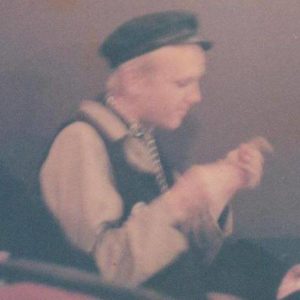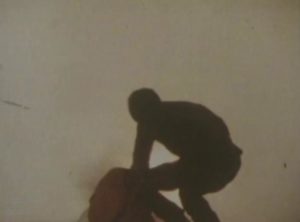1982: Neil Roberts Day
October 29, 2019
By AHNZ
 This day in New Zealand History, 18 November, 1982, is Neil Roberts Day. The 22yo Anarchist, Neil, died making a statement about the growing power of The State in our lives. His target was the perceived centre of the New Zealand Government intelligence repository, Wairere House in Wanganui.
This day in New Zealand History, 18 November, 1982, is Neil Roberts Day. The 22yo Anarchist, Neil, died making a statement about the growing power of The State in our lives. His target was the perceived centre of the New Zealand Government intelligence repository, Wairere House in Wanganui.
Also known as ‘the Kremlin’ and ‘Big Brother,’ Wairere House is where National 3.0 created ‘The Wanganui Computer’ as per the provisions of the Wanganui Computer Centre Act (1976.) New Zealand had never had a centralised national database like this before, and certainly not a computerised one. The data pool drew from Police, Ministry of Transport and Justice records in the name of law enforcement..
“It recorded motor vehicle registrations, driver’s and firearms licences, traffic and criminal convictions, and personal information about large numbers of New Zealanders. The Serious Fraud Office and local authorities were later given access to this information.”- NZ History.gov

With the benefit of being a later vintage of anarchist myself, I could never share Neil’s 1970s fears. I have every confidence that Police Minister’s schemes like this are a bungling pretence at fighting crime at great expense and for little or no result. In my opinion the entire system would have been obsolete very fast and far from being trouble for criminals it would be innocent citizens put into jeopardy because of the leaking of their personal information! But that’s not a perspective available to freedom lovers in 1982.
Skynet
Artists like James Cameron and Roger Donaldson encapsulated the same fears Neil Roberts must have experienced. Donaldson’s Sleeping Dogs (1977) explored C.K.Stead’s vision of New Zealand as a brutal dictatorship. Cameron’s nightmare about unstoppable machines without mercy became The Terminator (1984.) Even today, Cameron’s vision of Skynet is relevant as his latest iteration hits movie screens worldwide with Terminator Dark Fate (2019.)
In the Terminator Saga, the machines man has created to serve him turn against him. The central computer, Skynet, becomes self-aware and acts to preserve itself from being destroyed. The protagonists of the story identify Skynet in its primitive form and set out to blow it up before it becomes truly unstoppable.
“We have maintained a silence closely resembling stupidity”- Quotation from 1809 written by Roberts’ as graffiti before his act and just over the road from his ‘Skynet’
 Neil, an activist not an artist, literally lived out this script. Just as the ‘heroes’ in Terminator, Neil viewed himself as one of the few to recognise the existential threat and the fewer still willing to act on it. He looked upon himself as breaking a silence, or a stupidity, toward what New Zealanders saw as a domestic spy centre created to listen in on all our daily conversations. Before it could grow and Thought Police come knocking on our doors he would knock loudly, explosively, on theirs!
Neil, an activist not an artist, literally lived out this script. Just as the ‘heroes’ in Terminator, Neil viewed himself as one of the few to recognise the existential threat and the fewer still willing to act on it. He looked upon himself as breaking a silence, or a stupidity, toward what New Zealanders saw as a domestic spy centre created to listen in on all our daily conversations. Before it could grow and Thought Police come knocking on our doors he would knock loudly, explosively, on theirs!
“Exceptional Young Guy With Great Future”
Robert’s suicide note is in a messy hand and written on a tatty bit of cardboard, “Here’s one anarchist down. Hopefully there’s a lot more waking up. One day we’ll win—one day.” By this point, Neil had embraced Slave Culture, as evidenced by his suicide bombing. Yet, the Roberts family was clearly Dignity Culture stock so how did Neil go so far astray?
Roberts’ wealthy family lived in the eastern suburbs of Auckland. I deduce he was a very ‘good’ boy who worked hard to conform at a ‘good’ school under very controlling parents. Mum and Dad must have put Neil under great anxiety to be polite and pressure to please them and dress properly. If he conformed, the covenant stated, he would reap White Anglo Saxon Protestant rewards and, what’s more, then he would have earned their love.
 Work hard, he did. In 1980, aged just 19, Neil had saved up enough money to buy his own house by putting away $5,000 for the deposit. Neil’s employer at this time wrote a letter of recommendation to the bank to help smooth the way because, to him, Roberts was somebody special. “Exceptional Young Guy With Great Future,” both talented and creative who had the potential to go a long way in the restaurant business. Neil had been working that past year as assistant chef and things hummed along for six months further until a drastic change fell upon the young man.
Work hard, he did. In 1980, aged just 19, Neil had saved up enough money to buy his own house by putting away $5,000 for the deposit. Neil’s employer at this time wrote a letter of recommendation to the bank to help smooth the way because, to him, Roberts was somebody special. “Exceptional Young Guy With Great Future,” both talented and creative who had the potential to go a long way in the restaurant business. Neil had been working that past year as assistant chef and things hummed along for six months further until a drastic change fell upon the young man.
No Future
In February 1981, Neil underwent a radical “overnight” change from the hard-working straight laced ‘good’ boy. He quit his job and changed his clothes. Neil became an activist, a Springbok Tour protester, an anarchist, a Punk…
“The U.K. and N.Z. were well due for demolition. In the middle of the Muldoonist Slave Culture time period (1975-80) came the call of dissatisfied youth. They looked at the square, stolid, slavish, stale culture and detested its repression. They looked at their conformist parents and communities with a will to transform and regenerate but, at this point, to smash the old to make room for the new.”- 1978: Punk; AHNZ
 Roberts mutilated his body, having tattooed on his chest the words, “This punk won’t see 23, no future.” He coloured his hair pink, and he also shaved his hair off. He acquired a police record, he consumed illicit substances. He wore safety pins in his ears with razor blades dangling from them. He wore a dog collar around his neck sometimes and at other times a chain. In this picture Neil is reading (probably Anarchist literature) while wearing what appears to be a dog’s choke-chain around his throat.
Roberts mutilated his body, having tattooed on his chest the words, “This punk won’t see 23, no future.” He coloured his hair pink, and he also shaved his hair off. He acquired a police record, he consumed illicit substances. He wore safety pins in his ears with razor blades dangling from them. He wore a dog collar around his neck sometimes and at other times a chain. In this picture Neil is reading (probably Anarchist literature) while wearing what appears to be a dog’s choke-chain around his throat.

Finding Punk was a catharsis for Neil, the pressure of a lifetime of conformity was released. He could finally see that he was a Slave in his own life and quit playing the active role in pretending otherwise for the satisfaction of his Bosses. Neil’s self-image was that he was a doomed man, a dog to be mistreated and ordered to perform tricks on a sinking ship. Neil’s only power was to deprive this tormentors, teachers and parents, from the satisfaction of his obedience. No more tricks. No more dressing up; He was a dog, he would be the dog. Must he ‘grow up, grow old and become one of them or else die?’ Then, he hoped to die before he got old¹.
This is how Slave Culture overcomes Power every time. In this case, Neil was fighting a battle to force Muldoonist Slave Culture to end and he used the same old methods SC folk always have…
“As we know from the history of the High Middle Ages this is how being burned alive at the stake and being hung, drawn, and quartered finally came to an end as institutions. The SC victims learned to participate in their own murders willingly and as an act of piety; What could be more Clown World than this?”- Scepticism Culture; NZB3
“This is much more in the tradition, for example, of those monks who burnt themselves in front of parliament buildings and things.”- Nicky Harger; An anarchist with a death wish; Youtube
“Hey remember I decided to kill myself so therefore I became a Punk; Not because I was a punk I decided to kill myself.”- Robert’s suicide note (ref below) acknowledges Punk as a means to a pre-determined end
Punk had almost run its course when Neil found it (or it found him.) It was ending even as he adopted it so the cause he connected with was passing away; It must have felt like the oasis he had found was drying up. Despite the “no future” perceptions, Neil’s contemporaries (who lived) were able to transition into a new iteration of New Zealand and make a life for themselves. The Intersectional Anarchism and Punk itself was breaking up but rather than find a new beginning, a new identity, Neil resolved to die out with it.
Judgement Day
 Punk Roberts left his clique in Stratford for a bus to Wanganui. From 8am on 17 November he spent the day in that town preparing for his big finish. Roberts gratified the toilet block, signing off with an ‘Anarchy is Order’ symbol. He purchased a battery from the petrol station to power the detonators to his gelignite sticks. He wrote his suicide note with a hammering heart. It must have been a long summer’s day, this Wednesday alone in Wanganui. There was no need to find accommodation.
Punk Roberts left his clique in Stratford for a bus to Wanganui. From 8am on 17 November he spent the day in that town preparing for his big finish. Roberts gratified the toilet block, signing off with an ‘Anarchy is Order’ symbol. He purchased a battery from the petrol station to power the detonators to his gelignite sticks. He wrote his suicide note with a hammering heart. It must have been a long summer’s day, this Wednesday alone in Wanganui. There was no need to find accommodation.
 After midnight, at 12:35am on the Thursday, Neil with his red bag walked up to the armoured door guarding Wairere House. It may be that Roberts had enough batteries and detonators and timing devices to have taken this door out and come back for more. He certainly had enough explosives to have done so. He may have gone full Terminator 2: Judgement Day and blown from a place of cover then entered the computer fortress to wreck the interior? Or perhaps the plan all along was to strike once, strike big.
After midnight, at 12:35am on the Thursday, Neil with his red bag walked up to the armoured door guarding Wairere House. It may be that Roberts had enough batteries and detonators and timing devices to have taken this door out and come back for more. He certainly had enough explosives to have done so. He may have gone full Terminator 2: Judgement Day and blown from a place of cover then entered the computer fortress to wreck the interior? Or perhaps the plan all along was to strike once, strike big.
The physical result was to blow Neil and the door to smithereens. The two guards within were stunned but not harmed. Wairere House became Ire House but the work was not stopped, the Kiwi Skynet not damaged. The political policy not changed. Punk still flamed out, the Anarchists still fractured apart, and the expensive white elephant sunk into obsolescence at just the same pace as before. We don’t know but may assume that the greatest blow was upon Robert’s bourgeois parents both socially and to whatever they had for a heart to be broken. The fact that we don’t know them or their reaction suggests this family had some political and media pull. I’m tempted to suggest that Neil’s father was himself a policeman (or else not far from it) because of the nature of Roberts’ target.
Neil Roberts’ remains were cremated the day after the bombing in a private ceremony nearby. His story is not well known, nor has he been forgotten. There’s a film, an opera, frequent articles, and annual punk remembrance days that keep the memory of Neil alive. We would like to see Roberts as our Guy Fawkes, a wise man who gave his life cutting off dystopian oppression at its knees as an example to us all. This folk hero status eludes Roberts’ memory partly because we sense he did this for himself not for us. Mostly though, I think, his act fails to resonate because it came a beat too late. Slave Culture was over, Punk was over, the Springbok Tour Riots were over. New Zealand had moved on from blunt violent acts and trying to manipulate the Bosses into creating better conditions. We would do that ourselves now. In an Honour Culture New Zealand, Roberts and his explosive tantrum had already become anachronistic.
—
1 As in, “I hope I die before I get old.” from My Generation; The Who in 1965, the previous generation of Slave Culture. There’s a false premise here that the detested teachers/parents are not conscious beings who choose their own values and could ever reform. There is no talking to them. Corruption and purity are a function of age alone. By the same logic, Neil could not save himself by mental process but only by stopping his time clock (at 23) before he ‘turned into a pumpkin’. As a Concrete Culture it’s typical that SC would see things in such basic blunt terms. It takes a more abstract mind to accept that age, wisdom, goodness, and respect don’t necessarily go hand in hand.
Ref. NZ Herald (19-20/10/1982)
Ref. Wanganui Computer Centre Act 1976; NZLII
Ref. We have Maintained a Silence Closely Resembling Stupidity; Trishclark.co.nz; Or, Archive.org
Image ref. Kev’s Wanganui Riverboat History page; Facebook
Image ref. Roberts in dog collar reading book; Remember Neil Roberts; Facebook
Image ref. Roberts final moments; The Maintenance of Silence (1985); NZ On Screen
Image ref. Wairere House exterior in ruins; Alexander Turnbull Library
One thought on "1982: Neil Roberts Day"
Leave a Reply
 Like Comment Share
Like Comment Share








At the time of Neil Roberts death I was working long hours trying to succeed and own a home. His death was not in vain as for me I questioned, why. I saw the razorblade ear rings on both sexes with some wonderment at the time. They were a striking sight to see walking down the street with Blue Gillettes flashing in the sunlight, especially the angry young females. Looking back maybe I started to “wakeup” a little.